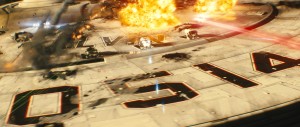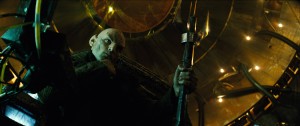In the second of our holiday weekend reading ‘DVD’ stories we share an extra double interview with Digital Domain and Svengali FX’s work on the JJ. Abrams directed Star Trek.
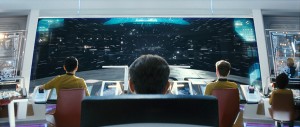 Don’t miss our original fxguide coverage of Star Trek including our interview with JJ. Abrams in fxguidetv #58 and our fxpodcast with ILM’s vfx supervisor Roger Guyett.
Don’t miss our original fxguide coverage of Star Trek including our interview with JJ. Abrams in fxguidetv #58 and our fxpodcast with ILM’s vfx supervisor Roger Guyett.
Digital Domain
Digital Domain, under the supervision of VFX Supervisor Kelly Port, contributed 140 shots to JJ Abram’s Star Trek. Darren Poe (Digital Effects Supervisor) and Lou Pecora (Compositing Supervisor) talk about how it was done.
fxg: Can you give me an overview of Digital Domain’s work for Star Trek?
Darren Poe: We did a number of sequences that ILM farmed out to us. One of them was the pipe sequence in the engineering bay where Scotty is mistakenly transported into a network of water pipes that Kirk then has to rescue him from. We did a phaser battle sequence. We did some character augmentation – some eye replacements and a CG mask on a robotic cop. We also worked on some set extensions for the cornfield sequence. We put in some futuristic skycrapers and removed some of the modern day elements from the plates.
Lou Pecora: And we did some set extensions in the Academy hangar. We also did a sequence that got cut.
Darren Poe: Yeah, there was a prison planet flashback sequence where we did a lot of set extensions and character augmentation. Ultimately, the sequence was cut from the film.
fxg: Can you talk about how you interacted with ILM and the overall vfx supervisor?
Darren Poe: Roger Guyett, the overall VFX Supervisor, was down in LA quite a bit working with us and other facilities. He would come in and be part of our normal walkthroughs and shot reviews. And then we’d use CineSync when he wasn’t available. Generally, we’d show our stuff to Roger, we’d package that up and he’d take things over to the studio to JJ and we’d get feedback from editorial.
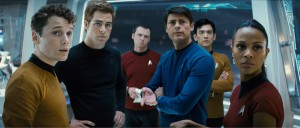 fxg: What sort of concept work or previs did you look to?
fxg: What sort of concept work or previs did you look to?
Lou Pecora: We had some art department reference for the crusher and pipe sequence. It ended up varying a little away from that, as always happens – not too far, but there was some 3D development involved. Do you like these blades? No, not menacing enough. OK, how about these? Oh, not scary enough. There was some back and forth.
fxg: What was involved in the pipe sequence effects?
Lou Pecora: The biggest challenge for us on that sequence was lining up all the CG pipes to the practical pipes. It was all shot with wide-angle anamorphic lenses. We didn’t have the exact lens matches for our distortion tools. A lot of it ended up being multiple tracks per shot. So, we could focus on the pipes at the back, for instance, and get those pipes working. Then we could use a different track for the pipes closer to camera. You’d see if those things were swimming against each other. It was quite a maze of pipes, like a hamster run, so getting those things working at the different depths was tricky. It also seemed like they were running around with the camera in there. There was a lot of bouncy, high energy frenetic motion going.
Darren Poe: That scene was shot in a large brewery-like industrial environment where they had brought in a bunch of set pieces for the connecting pipes. So there would be a section of orange pipe and then glass. We extending the sections sometimes and also had to replace them entirely or paint them out and track in clean plates.
Lou Pecora: Some of the look development of the liquid in the pipes and the refractive qualities were also challenges. We had to work out what we were going to do in CG and what would be 2D distortion. It also involved integrating practical elements in with the CG so that the bubbles appeared.
Darren Poe: We had some bluescreen plates of Scotty underwater that we then had to hand-off to our digital double of Scotty once the sequence got rolling. There was quite a bit of work in matching textures and animation.
One of the things about the anamorphic lenses was that the movie features lots of flares. So for a shot where we replaced half of the set with CG pipes, we also had to deal with the flares. In the background there were lots of bright lights casting anamorphic flares, so we had to try and put them back over the top or replace them. It was really important to try and keep those lens aberations in as much as possible.
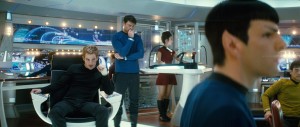 fxg: I really liked those flares!
fxg: I really liked those flares!
Lou Pecora: Yeah, just remember that each time you see those that was one night that some artist didn’t get to say goodnight to his kid. I like those flares a lot, but they were difficult to get back in there sometimes!
fxg: Can you talk a little about the phaser sequence?
Lou Pecora: The funny thing about phasers is that you think, ‘Phasers? That’s going to be easy!’ But it was not at all easy. There’s just so many ways that you can do them. They could be coming in fast, they could be individual beams, or they could be broken up in dotted lines. Or they could come out in bursts. Are the bursts symmetrical? Is it the same every time they’re shot out? Do they vary from thing to thing? We really went through a lot of iterations of those phasers. The director had some different ideas about what the phasers should look like than what we had seen in other Star Trek movies. So he wanted to take it in a different direction. I think this was great – it ended up looking great, but it just was a challenge getting there. The frenetic motion in the camerwork made it a little difficult to read sometimes. Tracking them in there and making sure they weren’t overpowering was a delicate balance. And of course, JJ likes his flares, so we had to put them in there and make sure people weren’t saying, ‘Hey, where’d all the flares go?’
Darren Poe: To do it right, you had to get all the reflections right. The bolt is a really bright, high energy pulse and we had to make it interact in the complex set they were flying through. So there was a lot of attention paid to the interactive lighting.
Lou Pecora:: For example, getting rid of shadows was important. When a bright light passes by something it should get rid of the shadow that would normally be there – the occlusion shadow of an object. So you have to get rid of that shadow in order to buy the shot. If you just brighten the shadow, it looks like you’ve just brightened up the shadow.
fxg: What tools did you use for the phaser battle?
Darren Poe: We did it all in 2D in Nuke. We did some look development for the look of phaser bolts. We built a library of different bolts that could be shot in 3D camera space and then we roto’d and comped these into the shots.
fxg: How did you achieve the character augmentation work?
Darren Poe: For the alien, Keenser, it was a character in a mask. His eyes were visible so we had to replace his eyes and put in sockets. So his eyes became these metallic posts. What we had to do was track the actor’s head and the movement of the actor’s eyes. We built a special rig because it was important where these posts were pivoting from and catching the light, and it had to be based on the dialogue too. We wanted to give him some expression because otherwise it was kind of an odd look with these two posts sticking out. We tried to give him some personality.
The cop was more a straightforward 3D model, a mask replacement really. There was an actor on set in a cop uniform. ILM sent us a bunch of different designs for masks. JJ picked one he liked and then we modelled it and lit it. We tracked it to the actor’s head to cover what was necessary.
Lou Pecora: It was modeled in Maya, rendered in RenderMan and comped in Nuke. There were also several shots in that sequence where the cop is riding a futuristic flying bike. It was built on a rig and we had to go back in and remove most of the rig and extend the bike. For some of the shots, we had to separate the bike from the plate and re-animate it a little to make it look like it was flying. We removed shadows cast by the rig and then re-projected in clean plates in 3D and comped the flying bike over the top of that.
fxg: Can you talk about the set extensions?
Darren Poe: For the cornfield sequence, where Kirk is racing in the ‘Vette, the skyline was a modern one and we were tasked with putting in a futuristic one instead with giant buildings. It had to sit behind the cornfields and be keyed back in with the very frenetic camera motion. Mostly the buildings were silhouetted in that sequence. We went with a matte painting approach.
Within the hangar, a lot of set extensions were done by taking pieces from plates shot for that sequence and cloning patches to fill in details. You’d have shots where there’d be almost a 120 degree rotation and all of a sudden you’d have a patch of bluescreen or greenscreen in the background that happened to be covered in smoke. So that would need a patch over it, and then some practical smoke over it to integrate it into the scene.
fxg: I love the look of the silhouetted buildings, because it left you wondering what they were. They were very imposing.
Lou Pecora: It’s funny you mention it that way, because when we first put them in, it was very explicit. You could clearly tell what they were. The director wanted to go with a more mysterious look, so we played them down as silhouettes, keeping them deliberately vague.
fxg: I think that’s a good example of how the effects fit into the story of Star Trek.
Darren Poe:: One of the things I like about a director like JJ Abrams is that it’s all about the story, every little piece of it. Every one of the comments we got back about our shots was that they were there to further the story. Not just to have gratuitous shots – the ‘Wouldn’t it be cool if…?’ shots. It all felt like these elements were there to serve the story. That’s one of nice things about this project. They weren’t show-off effects going on top of an empty story.
Lou Pecora: Everybody on it at Digital Domain was excited to be part of something big. It was exciting taking part in something that, although it had been done many times before, was bringing a new spin on things.
Svengali FX
Jamie Venable (VFX producer) and Stefano Trivelli (VFX Supervisor) discuss Svengali FX’s work for Star Trek.
fxg: How did Svengali get involved with the film?
Jamie Venable: We were contacted by Shari Hanson (the overall VFX producer) to assist in a number of things. The first was to see if Stefano could help JJ Abrams in preparing all of the VFX shots for a studio temp screening. That was our introduction to JJ, as they were prepping for that screening. Then, we were asked to help ILM, who were obviously the huge house on this show, to get some of the work done. Since Stefano already had a good relationship with JJ and knowledge of the actual work, it made sense to bring us in on the project.
fxg: What did the temp shots involve?
Stefano Trivelli: Most of the work was compositing, with some environment work. It went from simple stuff like touching up frames to creating full projected environments or making things look bigger.
fxg: Can you take me through some of your final shots for the film?
Stefano Trivelli: We worked on the environment for the auditorium shots at the Starfleet Academy where Kirk (Chris Pine) is being questioned. The same environment is used at the end of the film where Kirk receives an award. That location wasn’t big enough to put in all the cadets, so they filmed it using greenscreen and asked us to make it bigger and include more people. We were able to change a few things. The real location was a little too squareish – it was a modern location, not set in the future – so we made things a little more rounded. We added logos of the Starfleet Academy and generally made it more futuristic.
For the people themselves, we worked with Roger Guyett (the overall Visual Effects Supervisor) to come up with ideas to make the technical approach to the shots as simple as possible. Sometimes you end up doing things that are overly complicated but not necessary. So, for example, for the people in the back, instead of making them all CG or using something like Massive, we used real people. They were shot on bluescreen at ILM by Roger (who was also the second unit director on the film). We sifted through two weeks’ worth of dailies to select appropriate takes. Then we put the people on cards and added them to the back. It was working well for the scene, especially for the camera move JJ had used. It was also perfect in terms of the look, because it was real people. We had a few days of shooting people on bluescreen. We’d shoot in groups of five, or shoot single people, standing or sitting down, depending on the sequence.
Then we imported the geometry of the Starfleet Academy in Nuke, and then placed the people on cards in 3D space. It involved a lot of organisational-type work to make sure it worked in the right way. The movie was shot in the anamorphic, so that also needed to be taken care of in compositing the shots.
fxg: It’s definitely a seamless shot.
Stefano Trivelli: That was certainly what JJ and Roger wanted; realism. JJ wanted a lot of lens flares everywhere in the movie, too. I think it really gives the movie a particular look – something different and interesting. They were basically all real flares. They shot elements on black and provided them to us to incorporate in the scene. JJ really loves things to be realistic, in the true meaning of that. The level of quality was so high. It had to hold up to ILM and Digital Domain’s work too. We needed to make sure there was no jump between the facilities’ work, which is really thanks to Roger who kept everything consistent.
fxg: What was another shot you worked on?
Stefano: We worked on the environment to introduce the Trail Bar before Kirk goes in. Our shot is an establishing shot of the Iowa landscape that shows a futuristic city, the Enterprise dockyard off in the distance and a local bar. A futuristic vehicle approaches the bar at sunset. They shot an aerial plate from a helicopter of farmland, with a camera move. We used that as a guideline. The plate was a starting point to give some textures for the matte painting. Then, our matte painter, Michele Moen, started building things from scratch – the sky, the background, the actual city in the distance and the Enterprise dock. ILM actually gave us those elements as reference because they were doing those things in other shots.
For the bar, we built some simple geometry, as well as for the motorcycle-like vehicle that’s approaching the bar. We tried to make the shot not too complicated technically, so that we could go back in and tweak it if necessary. The final shot was executed by projecting the painting onto geometry in Nuke and then animating and compositing also in Nuke.
fxg: What were the main pieces of hardware or software you used for your shots?
Stefano Trivelli: Svengali is all based on Macintosh computers. About 95% of the shots were composited on Nuke, with a few on Shake. For the environments, we used Maya or Nuke, depending on the complexity of the shot. We used Maya to create the geometry, but there weren’t any fully CG shots, in that sense, because our environments were projected matte paintings. We wanted to take advantage of our artist’s specialities, especially Rocco Gioffre and Michele Moen, who are true matte painters from the old days. They’ve worked on films like Blade Runner and the original Star Trek. We wanted to take advantage of their artistic skills and go from there.
fxg: The shots are clearly part of the storytelling process. Do you like working on these sorts of films?
Stefano Trivelli: Yeah, I was really lucky to be in production for a couple of months at Paramount, helping with the shots for the screening. I was right there with the editor, and JJ was always stopping by, so they were able to test stuff on the fly and see how it was looking. That gave us a chance here at Svengali to see how the movie was shaping up, which was helpful and exciting at the same time. You could really see the movie was going to be interesting. It also let us figure out how our shots were fitting into the movie. You knew what the purpose of the shots were. Also, it was wonderful working with JJ. He’s a great guy, always so enthusiastic. It’s almost contagious to everybody around him. He’s always nice and respects your ideas. Personally, this was one of the best movies I’ve worked on. It was hard (a lot of nights as usual in this business!) but definitely worth it. A great experience.
fxg: Sounds like a great project for Svengali, where you got involved in both production and final shots.
Jamie Venable: Well, we’re just starting our seventh year. We’re not a big facility, but the calibre of artists that we have is amazing. Most people have worked at ILM or Weta or on big shows. We’ve been able to develop a great core nucleus of artists. The way we’ve been able to fit in with these big effects movies is that we’re very responsive. We don’t have an enormous pipeline, but we’re able to match the big facilities’ work. We don’t go after the full CG character-animation work, but at the same time there’s a role for us to fill the gaps or establish scenes that we’re really good at. Then when it comes to crunch mode, we’re able to pick up where those big places are or fill in with any late edits or changes. That’s the role we’ve been able to play.
We always try to be invisible and help tell the story. For example, some of the other work we did for the film involved a bug that Nero (Eric Bana) threatens to ram down Captain Pike’s (Bruce Greenwood) throat. As shot, it ended up looking a little too mechanical, so we went in frame by frame and painted out the pincers, then re-painted in parts of Eric Bana’s face that were obscured originally by the pincers. We also had to animate movement of the bug so that it looked like it was struggling before it got rammed down the throat. I think that’s an example of where something’s filmed that wasn’t necessarily planned for, and we were able to go in there and make those changes with excellent seamless results.


